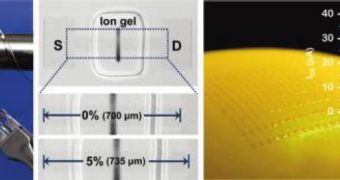Continuing with the string of graphene research breakthroughs, some researchers from Korea discovered a way to make the carbon-based material stretch when part of a transistor.
Graphene is not the first material that researchers tried to use in making stretchable, transparent electronic components.
This didn't stop it from being the first to actually work properly in such scenarios though.
Indeed, a team of Korean researchers were successful in their quest to make this sort of transistor, by layering sheets of graphene on copper foil and then bonding everything to a rubber substrate.
After that, the transistor channels were etched into the surface, leaving only for the electrodes and gate insulators, made of ion gel, to be printed on top.
“Our work includes important results compared with stretchable and transparent devices reported in the previous literature,” said Jong-Hyun Ahn from Sungkyunkwan University in Suwon.
“In fact, it is nearly impossible to fabricate transistors that offer both mechanical stretchability and high optical transparency on unusual substrates such as rubber slabs or balloons by using conventional materials. In particular, graphene devices have the advantage that they can be integrated using printing processes at room temperature without vacuum or high-temperature steps. The capabilities of these systems go far beyond conventional material-based systems.”
The team behind the breakthrough is led by Ahn and Jeong Ho Cho from Soongsil University in Seoul.
The transistor can stretch about five percent (maximum) without losing electrical efficiency. Further research should increase this elasticity.
“We will make an effort to improve the range of stretchability and the electronic properties of the current graphene devices and apply them to various wearable electronics and sensory skins,” Ahn said.
“Stretchable electronics could be useful for various current and future applications, such as wearable displays and communication devices, conformal and stretchable biosensors (brain sensors, balloon catheters, etc.), sensory skin for robotics, and structural health monitors and eye-ball cameras.”

 14 DAY TRIAL //
14 DAY TRIAL //